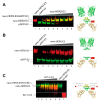Modular Site-Specific Conjugation of Nanobodies Using Two Co-Associating Tags
- PMID: 36430882
- PMCID: PMC9696751
- DOI: 10.3390/ijms232214405
Modular Site-Specific Conjugation of Nanobodies Using Two Co-Associating Tags
Abstract
The homogeneous labeling of antibodies and their fragments is a critical step for the generation of robust probes used in immuno-detection applications. To date, numerous chemical, genetic and peptide-based site-specific coupling methods have been developed. Among these methods, co-assembling peptide-tags is one of the most straightforward and versatile solutions. Here, we describe site-specific labeling of nanobodies through the use of two co-associating peptides tags, E3 and K3, originating from the tetramerization domain of p53. These E3 and K3-tags provide a simple and robust method for associating stoichiometric amount of VHH and fluorescent probes, either fluorescent proteins or fluorochromes, at specific positions. As a proof of concept, a nanobody targeting the human epidermal growth factor receptor 2 (HER2), the nano-HER2 was genetically fused to the E3 and associated with different fluorescent K3-derivates. Entities were produced separately in Escherichia coli in soluble forms at high yields and co-assembled in vitro. These molecular probes present high binding specificity on HER2-overexpressing cells in flow-cytometry with relative binding constants in the low nanomolar range and are stable enough to stain HER2-receptor on living cells followed detection using fluorescent confocal microscopy. Altogether, our results demonstrate that the non-covalent conjugation method using these two co-associating peptides can be easily implemented for the modular engineering of molecular probes for cell immuno-staining.
Keywords: VHH; conjugation; nanobody; site-specific.
Conflict of interest statement
The authors declare no conflict of interest.
Figures




References
-
- Crauwels M., Massa S., Martin C., Betti C., Ballet S., Devoogdt N., Xavier C., Muyldermans S. Antibody Engineering. Volume 1827. Humana Press; New York, NY, USA: 2018. Site-Specific Radioactive Labeling of Nanobodies. - PubMed
-
- Massa S., Vikani N., Betti C., Ballet S., Vanderhaegen S., Steyaert J., Descamps B., Vanhove C., Bunschoten A., van Leeuwen F.W.B., et al. Sortase A-Mediated Site-Specific Labeling of Camelid Single-Domain Antibody-Fragments: A Versatile Strategy for Multiple Molecular Imaging Modalities. Contrast Media Mol. Imaging. 2016;11:328–339. doi: 10.1002/cmmi.1696. - DOI - PubMed
-
- Pleiner T., Bates M., Trakhanov S., Lee C.T., Schliep J.E., Chug H., Böhning M., Stark H., Urlaub H., Görlich D. Nanobodies: Site-Specific Labeling for Super-Resolution Imaging, Rapid Epitope- Mapping and Native Protein Complex Isolation. Elife. 2015;4:e11349. doi: 10.7554/eLife.11349. - DOI - PMC - PubMed
MeSH terms
Substances
Grants and funding
LinkOut - more resources
Full Text Sources
Research Materials
Miscellaneous

